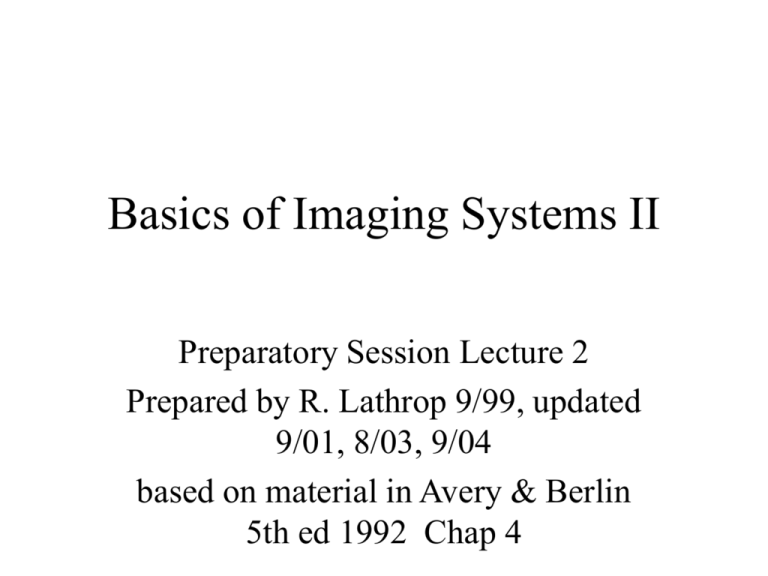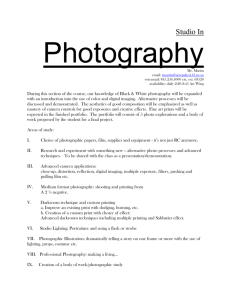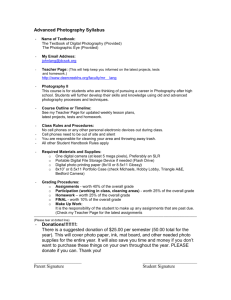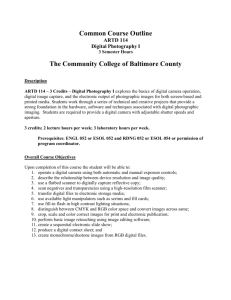Principles of Photogrammetry: Scale
advertisement

Basics of Imaging Systems II Preparatory Session Lecture 2 Prepared by R. Lathrop 9/99, updated 9/01, 8/03, 9/04 based on material in Avery & Berlin 5th ed 1992 Chap 4 Photogrammetry • Photogrammetry is defined as the technique of obtaining reliable measurements of objects from photographs • To make accurate measurements it is necessary to determine, as accurately as possible, photographic scale Types of aerial photos • Vertical photos - camera axis vertical • Tilted photos - 1-3o off vertical, virtually all aerial photos are unintentionally tilted • High oblique - intentional inclination, includes horizon • Low oblique - does not include horizon Mapping or metric camera • Single lens frame camera • High geometric quality • Film format is 230 mm (~9 in) on a side Keystone’s Wild RC-10 • Focal length of 152 mm mapping camera common • Fiducial marks for later registration and defining principal point of the photo B&W NAPP photo Digital Framing/Scanning Systems • Charge coupled device (CCD): electronic sensor sensitive to a particular wavelength of light, that are generally physically separate on the focal plane • RGB color image generally has separate RGB CCDs • There can be difficulty in spatial co-registering of the different wavebands for the same pixel Digital Mapping Camera: Zeiss/Intergraph Imaging •2d CCD matrix (array) to ensure a rigid image geometry similar to a traditional precision film platen •Panchromatic 7000 x 4000 pixels •Color 3000 x 2000 pixels •Separate lens for each band •Multiple smaller camera heads to create image rather than a single, large diameter •12 bit radiometric resolution http://imgs.intergraph.com/dmc/ Digital Line Sensing Systems: Leica Airborne Digital Sensor (ADS40) •Pushbroom linear array system rather than a 2D framing system •3 line scanners : forwards, downwards and backwards to provide for stereoscopic coverage •Three CCD sensors: B&W color (RGB) & NIR 12,000 pixels across •RGB co-registration through special trichroid filter that splits beam from single lens, rather than 3 different lens •Field of View of 64o •Produces up to 100GB of data per hour of flight http://www.gis.leica-geosystems.com/products/ads40/ Overlapping Stereophotography • Overlapping photography is needed to determine parallax and stereo/3D viewing • Endlap - ~60% • Sidelap - ~20-30% Pushbroom Scanning vs. 2D Framing Graphics from http://www.gis.leica-geosystems.com/products/documents/ADS40_product_description.pdf Photographic Scale • Scale defines the relationship between a linear distance on a vertical photograph and the corresponding actual distance on the ground • Photographic scale indicates proportional distance Photographic Scale • Scale expressed as a representative fraction (RF) between the linear distance on the photo (numerator) and the corresponding distance on the ground (denominator) • Example: 1/25,000 or 1:25,000 means that a length of 1 unit of measurement on the photo represents 25,000 units of measurement on the ground Small vs. Large Scale • Small scale: larger denominators objects appear small on the image image covers larger ground area e.g. 1:120,000 • Large scale: smaller denominators objects appear large on the image image covers smaller ground area e.g. 1:10,000 Alternative ways to express Photographic Scale • 1:24,000 can be expressed as 1 in. = 2,000ft 1 = 1 in * 12in = 12 in = 24,000 24,000 in 1ft 24,000 ft 1:100,000 same as 1 cm = 1 km 1:60,000 same as 1 in = 0.95 mi 1:300,000 same as 1 in. = 4.7 mi 1:1,000,000 same as 1 in = 15.8 mi 1 in 2,000 ft Photographic Scale d • Scale = f /H’ = d/D • where f = focal length H’ = height above terrain d = image distance D = ground distance h = terrain elevation H = flying height (h + H’) f H’ H D h Scale determination from focal length and altitude RF = f / H’ where: f = focal length H’ = flying height above terrain Example: f = 210 mm H = 2,500 m MSL ground elevation = 400 m RF = 210 mm * 1m (2,500 m - 400 m) 1000 mm RF = 1 10,000 or 1:10,000 = 210 . 2,100,000 Scale determination from photoground distance RF = PD / GD = d / D where: PD = photo distance between 2 points GD = map distance between 2 points Example: PD = 5 cm GD = 1,584 m RF = 5 cm * 1m = 5 = 1 1584m 100 cm 158,400 31,680 Scale determination from PhotoMap distances RF = PD / (MD * MS) where: PD = photo distance between 2 points MD = map distance between 2 points MS = map scale denominator Example: PD = 3.2cm MD = 6cm MS = 50,000 RF = 3.2 cm 6 cm * 50,000 = 3.2 cm 300,000 cm = 1 93,750 Effect of flying height on ground coverage H’1 > H’2 H’1 D1 > D2 H’2 x D2 D1 Adapted from Lillesand & Kiefer, 2nd edition Effect of focal length on ground coverage f1 f2 f 1 > f2 H’1 D1 < D2 x D1 D2 Adapted from Lillesand & Kiefer, 2nd edition Ground Coverage • Ground coverage, D, of photo frame varies with f and H’ • as f decreases, ground coverage increases e.g. f1 = 1/2 f2 D1 = 2D2 A1 = 4A2 • as H’ increases, ground coverage increases e.g. H’1 = 2H’2 D1 = 2D2 A1 = 4A2 Ground Coverage example Case 1 film size = 9.0” = 230mm f1 = 210 mm H’ = 12,200 m Scale = ? D=? 1 = 210 mm = MS 12,200m Case 2 film size = 9.0” f2 = 152 mm H’ = 12,200 m Scale = ? D=? 1 58,000 D = 230mm x 58,000 = 13.3km 1 = 152 mm = MS 12,200m 1 . 80,000 D = 230mm x 80,000 = 18.4km National High Altitude program (NHAP) • Flying Height, H’ = 12,200 m • color IR camera f = 210 mm scale 1:58,000 area per frame 13.3 x 13.3 km • panchromatic camera f = 152 mm scale 1:80,000 area per frame 18.4 x 18.4 km Ground Sample Distance (GSD) In digital camera systems interested in Ground Sample Distance = the size of the individual camera pixels projected onto the ground array element size * H’ GSD = . focal length Example: array element size = 0.009mm f = 28 mm GSD(m) = H’ = 1800m 0.009mm x 1800m = 0.6 m 28 mm A GSD of 0.6m does not necessarily mean we can resolve objects 0.6m in size. General Rule of thumb: GSD should be at least one half the size of the smallest object of interest. Example taken from Comer et al. 1998 PERS, pp. 1139-1142. Ground Coverage for Scanning Systems • W = 2 H’ tan q/2 tan f = opp/adj where W = swath width H’ = flying height above terrain q/2 = ½ FOV of scanner f Adj = H’ Opp = ½W Example: Leica ADS40 q= 64o if H’ = 2880 m H’ W = 2 x 2880m tan32o = 3600m q/2 W Determining Photo Orientation • Photo acquisition date, roll/frame #’s, and other annotation are almost always along northern edge of photo • Sometimes eastern edge is used • Only way to be certain is to compare photo to an appropriate map Map vs. Photo Projection Systems • Maps have a orthographic or planimetric projection, where all features are located in their correct horizontal positions and are depicted as though they were each being viewed from directly overhead. Vertical aerial photos have a central or perspective projection, where all objects are positioned as though they were viewed from the same point. Image Displacement • Relief displacement is due to differences in the relative elevations of objects. All objects that extend above or below a specified ground datum plane will have their images displaced. • The taller the object, the greater the relief displacement Even satellite imagery can have relief displacement Quickbird image of Washington Monument http://www.mfb-geo.ch/text_d/news_old_d8.html Radial Displacement • A photo’s central projection leads to image displacement where objects are shifted or displaced from their correct positions • Objects will tend to lean outward, i.e. be radially displaced. • The greater the object is from the principal point, the greater the radial displacement. • Example: cooling towers towards the edge of photo show greater radial displacement. Maps vs. Aerial Photos • Maps: Scale is constant No relief displacement • Photos: Scale varies with elevation Relief displacement Orthophotography • Orthophoto - reconstructed airphoto showing objects in their true planimetric position • Geometric distortions and relief displacements are removed • Orthophotoquad - orthophotos prepared in a standard quadrangle format with same positional and scale accuracy as USGS topographic maps • DOQ - digital orthophoto quad Digital Orthophotography: the new standard Distortions removed, rectified to a standard projection/coordinate system and in digital form for ready input to a GIS 2002 1 foot ground spatial resolution per pixel UTM or State Plane Aerial Photographic Sources • National High Altitude Photography (NHAP): (1980-1987) 1:58,000 CIR or 1:80,000 Pan • National Aerial Photography Program (NAPP): (since 1987) 1:40,000 CIR • NASA high altitude photography: (since 1964) 1:60,000-1:120,000 PAN, COLOR, CIR • These images are archived by the Eros Data Center as part of the USGS Global Land Information System. To search archive http://edc.usgs.gov/webglis Aerial Photographic Sources • USDA: (since 1955): mainly PAN of 1:20,000-1:40,000. These photos are archived by the Aerial Photography Field Office http://www.fsa.usda.gov/dam/APFO/airfto.h tm • National Archives and Records Administration archives older (pre- 1950’s) aerial photography http://www.nara.gov/research/ordering/map ordr.html Aerial Photographic Sources • National Ocean Survey (NOS) coastal photography: (since 1945), color, scales of 1;10,000 - 1:50,000 • The photos are used for a variety of geopositioning applications, which include delineating the shoreline for Nautical Chart creation, measuring water depths, mapping seabed characteristics, and locating obstructions to marine and air navigation. • http://mapfinder.nos.noaa.gov Digital Orthophotography Sources • New Jersey 1995/97 & 2002 digital orthophotos are available from the USGS Eros Data Center and the NJ Office of Information Technology. Individual images can be downloaded http://gisdata.usgs.net http://njgin.nj.gov • Or viewed interactively http://mapping.usgs.gov Contract Photography • Existing aerial photographs may be unsuitable for certain projects • Special-purpose photography - may be contracted through commercial aerial survey firms Contracting Photography Considerations • • • • • • • • Camera focal length Camera format size Photo scale/ground coverage desired Film/filter Overlap/sidelap Photo Alignment/tilt Seasonal considerations Time-of-Day considerations/ cloud cover Seasonal considerations • Cloud free conditions, ideally < 10% • Leaf-off: spring/fall when deciduous tree leaves are off and ground free of snow used for topographic/soils mapping, terrain/landform interpretation • Leaf-on: summer when deciduous trees are leafed out or late fall when various tree species may be identified by foliage color used for vegetation analyses Time-of-day considerations • Quantity of light determined by solar elevation angle no shadows: +- 2 hrs around solar noon shadows desired: early or late day • Spectral quality: possibility of sun/hot spots causing image saturation Flight Alignment • Flight lines are planned to be parallel • Usually in a N-S or E-W direction. For maximum aircraft efficiency, they should be parallel to the long axis of the study area (minimize aircraft turns). • Crab or drift should be minimized • Tilt , 2-3o for any single photo, average < 1o for entire project Example: Flight planning for aerial photography of submerged aquatic vegetation • Color film gives better water depth penetration Example: Flight planning for aerial photography of submerged aquatic vegetation • • • • Other considerations Scales of 1:12,000 to 1:24,000 needed Time of year: late spring-early summer Time of day: sun angles 15-30o, generally early morning to reduce wind/surface waves • Tides: +- 2 hours of lowest tide Example: Flight planning for aerial photography of submerged aquatic vegetation • • • • • • • GeoVantage Digital Camera 4 bands: Blue, Green, Red, NIR Pixel Array Size: 0.00465mm Focal Length: 12mm Field of View: 28.1o crossrange, 21.1o along range Easily mounted on wheel strut Coordinated acquisition with Inertial Measurement Unit to determine precise geodetic positioning to provide for georegistration and orthorectification Example: Flight planning for aerial photography of submerged aquatic vegetation • What Flying Height (m) needed to resolve individual SAV beds of 1m wide x 10 m long (0.001 ha in size)? • General Rule of Thumb: GSD at a minimum of ½ the size of smallest feature. In this case need, GSD of 0.5m. • GSD = array element size * H’ focal length • Example: array element size = 0.00465mm f = 12 mm GSD = 0.5m • H’ = 0.5m * 12 mm / 0.00465mm = 1290 m . H’ = ? Example: Flight planning for aerial photography of submerged aquatic vegetation • What will be the image width(m)? FOV = 28.1o • Remember your basic trigonometry? Tan = opposite / adjacent • Tan FOV/2 = (1/2 image width)/H’ • Image width = 2 * tan14.05 * 1290m = 2 * 0.250 * 1290m = 645 m adj H’ = 1290m opp






